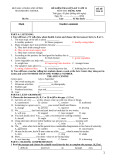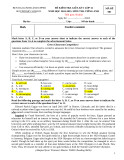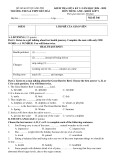Đề thi thử THPT quốc gia chuẩn cấu trúc Bộ giáo dục 2015-2016: Môn Tiếng Anh (Có đáp án)
Nhằm giúp các bạn củng cố lại kiến thức đã học và làm quen với dạng đề thi môn tiếng Anh, mời các bạn cùng tham khảo nội dung đề thi thử THPT quốc gia chuẩn cấu trúc Bộ giáo dục 2015-2016 "Môn Tiếng Anh" dưới đây. Nội dung đề thi gồm 64 câu hỏi trắc nghiệm và 5 câu hỏi tự luận có lời giải. Hy vọng đây là tài liệu tham khảo hữu ích cho các bạn.





















